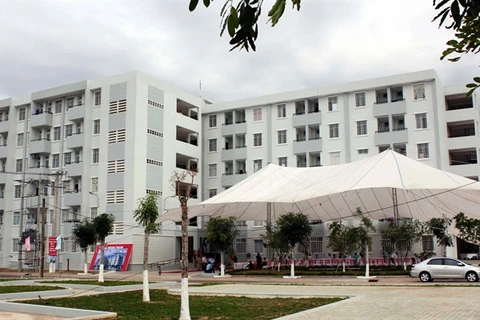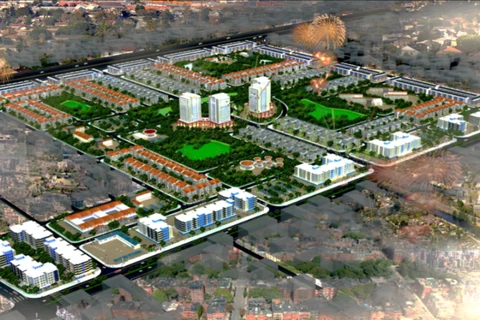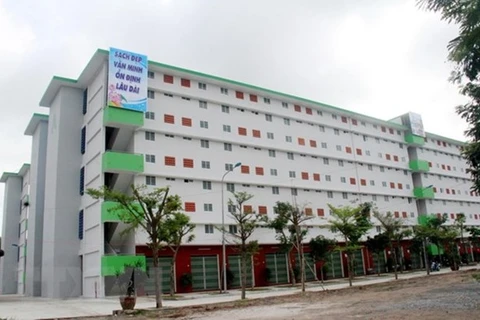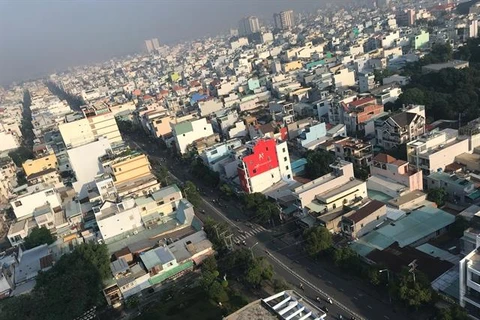Hanoi, (VNA) – Available social housing at present can provide stable accommodation for only about 28 percent of workers nationwide, which means the remaining 72 percent still have to rent rooms of private owners.
There are around 4.8 million workers working in industrial parks across the country. The appearance of more and more industrial parks and export processing zones has attracted large numbers of workers to industrial hubs such as Hanoi, Bac Ninh in the north or Ho Chi Minh City, Dong Nai and Binh Duong in the south.
Reports from localities show an estimated 1.7 million workers at industrial parks have housing needs in 2020. More than half of them are workers hailing from other localities. The rates are as high as 90 percent in Binh Duong province, 63 percent in Ho Chi Minh City, 60 percent in Dong Nai and 59 percent in Hanoi.
Big demand but supply is limited
Workers in industrial parks have low income. Most of them rent small rooms in houses built by local residents in areas around the industrial parks.
In Hanoi, some 2 million square metres of housing are needed to accommodate workers at industrial parks in 2020. In Ho Chi Minh City, available social housing can meet only 15.3 percent of demand of workers in local industrial parks.
That’s not to mention the housing needs of poor families and students from other localities.
Nguyen Trong Ninh, director of the Department of Housing and Real Estate Market Management (Ministry of Construction), said about 100 housing projects designed specifically for workers have been completed, providing 41,000 apartments, accommodating around 330,000 workers. This is only 28 percent of the demand.
Currently up to 226 social housing projects with about 182,200 apartments are under construction, but most of them have been behind schedule and some have been suspended. Some investors of those projects are asking for permission to convert them to commercial housing. As a result, social housing supply is very limited, with little possibility of improvement in the near future.
According to statistics of the management board of industrial parks in Hai Duong province, as of the end of 2018, the province had nearly 97,000 workers employed in local industrial parks. The number is expected to increase to 104,500 in 2020 and 248,000 in 2030.
Among those workers, 31,800 have housing needs in 2020, and an estimated 62,000 will have the need in 2030.
Meanwhile, Hai Duong’s housing development plan to 2020 with a vision to 2030, which was approved by the provincial People’s Committee in August 2018, set the target of raising the average housing ratio to 27 square metres per person in 2020 and 35 square metres per person in 2030. This means there should be 860,000 sq.m of housing for workers in local industrial parks in 2020 and more than 2.1 million sq.m in 2030.
The northern province of Quang Ninh has 11 industrial parks, which employ around 8,000 workers, but only 3,000 of them have stable housing. The remaining 5,000 workers struggle to have some place to stay.
In the northern province of Bac Ninh, more than 152,000 workers are employed at industrial parks, with 75,000 of them in need of housing. The number of workers and their housing need are increased at an average 20 – 25 percent each year.
Increasingly urgent demand
It is clear that social housing for workers in industrial parks remains limited, and it is urgent to act to solve the problem.
The 2014 Housing Law has stipulations on social housing, and the Government’s Decree 100/2015/ND-CP also contained detailed regulations on social housing, including housing for workers. Accordingly, commercial and urban housing projects are required to set aside 20 percent of the land for social housing. Those projects with areas under 10 ha can meet the requirement in the form of money, housing space or land area.
Projects with areas of more than 10 ha must build social housing. However, investment in housing for workers is still a drop in the ocean.
Many localities with industrial parks are not keen on investing in housing for workers, due to cumbersome procedures, time consuming preparations and slow ground clearance. The project approval process is time consuming, pushing up costs and discouraging investors.
Lack of housing is a reason behind the instable supply of workers. To keep workers, some enterprises introduced housing allowance at between 20,000 – 600,000 VND per worker per month, but it fails to address the root of the problem.
What is the solution?
The Prime Minister has issued Decision 655/QD-TTg approving a blueprint on building trade union’s facilities which are housing, kindergartens, supermarkets, and health care, sports and cultural facilities in industrial parks and export processing zones. The Vietnam General Confederation of Labour (VGCL) has been assigned to be in charge of implementing the blueprint.
Under the plan, all industrial parks and export processing zones nationwide should have trade union’s facilities by 2030.
At many meetings, the PM has made it clear that local administrations are the key to social housing development. He also required ministries, sectors and local administrations to focus on removing obstacles in workers’ housing development.
 The Cong Doan (trade union) kindergarten in Binh Hoa industrial park is the first facility built by the labour federation of An Giang province (Photo: VNA)
The Cong Doan (trade union) kindergarten in Binh Hoa industrial park is the first facility built by the labour federation of An Giang province (Photo: VNA) The Construction Ministry said to address problems in capital and land shortages for social housing, specific policies are needed to encourage investment through favourable conditions for land, land clearance, and administrative procedures./.


























